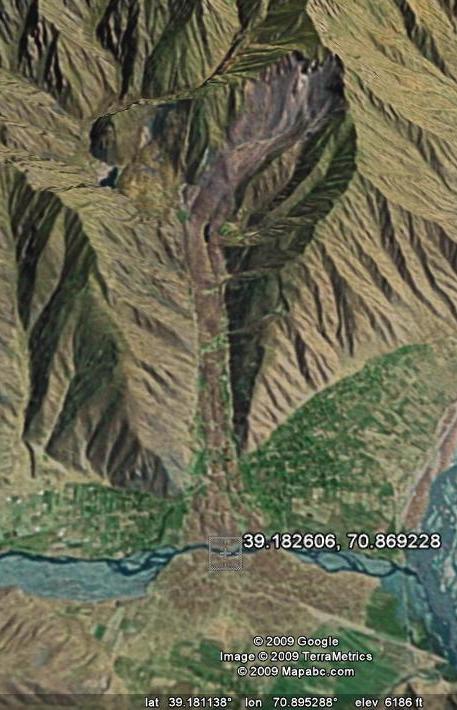13 September 2009
On the loss of life in landslides during the 1949 Khait earthquake
Posted by Dave Petley
Regular readers will know that one of my interests lies in trying to get a better understanding of the loss of life associated with landslides. A key realisation of this work for me has been that earthquake-triggered slides cause a very substantial proportional (probably in fact the majority) of fatalities is mass movement events. Unfortunately our understanding of seismically-driven landslides, and their impacts, remains poor, certainly in comparison with rainfall induced slides. For that reason, work to re-examine past seismically-driven events is very welcome, helping us to get a much better understanding of the range of processes and impacts in these events.
One significant but until now slightly elusive such event has been the 1949 Khait earthquake. This was a Mw=7.4 event on 10th July 1949 in the Tien Shan mountains of what is now Tajikistan, but was then the Soviet Union. The timing and location of this event, soon after the war in an area about which the Soviet Union was very secretive, has meant that it has been very difficult to determine any details about the landslides that were triggered in the earthquake. However, some rather speculative reports have suggested that the impacts were very large – for example this article in Mountain Research and Development reported a huge landslide at a site that it termed Borgulchak Rock. This slide was reported to have travelled 12 km. Some reports, such as the Wikipedia article on this landslide, have suggested a death toll as high as 28,000 people, although to be fair this may well be something of a misinterpretation of the original source.
An article in press in the journal Engineering Geology, by Steve Evans and colleagues (Evans et al. 2009 in press) seeks to re-examine the landslides triggered by this earthquake. Unusually for a science paper the article is a ripping-good read. The paper re-evaluates the Khait landslide, and the other large slide that was triggered in the earthquake, providing a rational analysis of the likely impacts of the mass movements.
First, they look at the Khait landslide (termed in the paper as a rockslide / loess flow), which is still clearly visible in the landscape, even on the low resolution Google Earth imagery available for this area:
 For the Khait landslide they conclude that the volume was probably rather lower than earlier estimates have suggested. The other landslide considered is a very large and complex flowslide that swept down the Yasman Valley, covering about 20 km. This slide had multiple source areas on the southern side of the valley:
For the Khait landslide they conclude that the volume was probably rather lower than earlier estimates have suggested. The other landslide considered is a very large and complex flowslide that swept down the Yasman Valley, covering about 20 km. This slide had multiple source areas on the southern side of the valley:
 They conclude that this is a rather destructive loess flow slide with a volume of about 245 million cubic metres. Remarkably it travelled over a slope with an angle of just two degrees!
They conclude that this is a rather destructive loess flow slide with a volume of about 245 million cubic metres. Remarkably it travelled over a slope with an angle of just two degrees!
Evans et al. (2009) then consider the fatalities caused by the landslides. By looking at contempory reports of the population of the Khait area and census data on settlement size and population density they reject earlier estimates of the loss of life. For the Khait landslide itself they conclude that about 800 fatalities is probably a reasonable estimate – note that this very considerably less than earlier estimates. For the Yasman Valley flowslide they estimate about 4,000 fatalities, and they determine that there were probably a further 2,400 deaths. This gives a total fatality count of about 7,200 – far lower than previous counts, but still substantial of course.
In conclusion, this is a very important contribution, filling in another gap in our understanding of previous landslide impacts. Steve and his colleagues have also just published a similar paper (Evans et al. 2009) re-examining the 1960 Huascaran rock avalanche in Peru. This will be the topic of an upcoming post.
Reference
Evans, S., Roberts, N., Ischuk, A., Delaney, K., Morozova, G., & Tutubalina, O. (2009 in press). Landslides triggered by the 1949 Khait Earthquake, Tajikistan, and associated loss of life Engineering Geology DOI: 10.1016/j.enggeo.2009.08.007
Evans, S., Bishop, N., Fidel Smoll, L., Valderrama Murillo, P., Delaney, K., & Oliver-Smith, A. (2009). A re-examination of the mechanism and human impact of catastrophic mass flows originating on Nevado Huascarán, Cordillera Blanca, Peru in 1962 and 1970 Engineering Geology, 108 (1-2), 96-118 DOI: 10.1016/j.enggeo.2009.06.020


 Dave Petley is the Vice-Chancellor of the University of Hull in the United Kingdom. His blog provides commentary and analysis of landslide events occurring worldwide, including the landslides themselves, latest research, and conferences and meetings.
Dave Petley is the Vice-Chancellor of the University of Hull in the United Kingdom. His blog provides commentary and analysis of landslide events occurring worldwide, including the landslides themselves, latest research, and conferences and meetings.
very nice.
Wowzerz